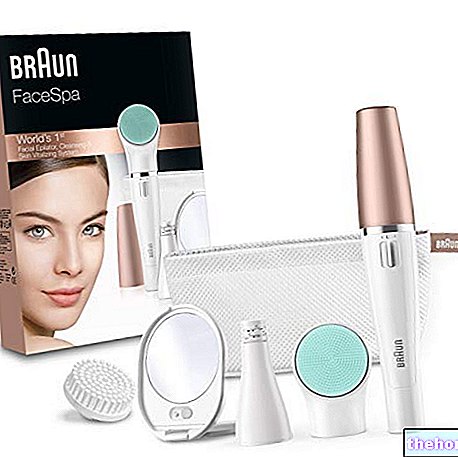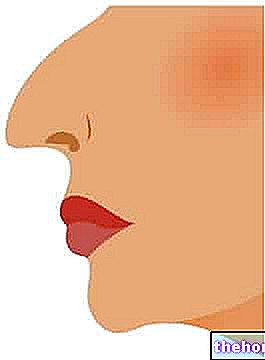What is keratosis pilare
Keratosis pilare represents a rather widespread skin disorder: it is a "trivial disease that alters keratinization at the level of the hair follicles. More specifically, keratosis pilaris affects the orifices of the hair bulbs in some areas of the body.

See other photos keratosis pilare
Generally, the skin disorder slowly regresses with age, and then disappears - in most cases - in old age. However, there are some more severe forms of keratosis pilare whose resolution does not occur spontaneously.
Incidence
As mentioned, keratosis pilare is a rather widespread skin disorder, so much so that it can be found in about 40% of the adult population and in 80% of the pediatric population. children, but the affected areas are different: in fact, if the thighs, buttocks and arms are the areas most affected by keratosis pilare among adults, in children the same manifestation is recorded above all in the cheeks and temples.
Furthermore, this type of disorder occurs indifferently in both sexes and without distinction of ethnicity.
Causes
Also for this skin disease, the cause is unknown; the only certainty is that keratosis pilare is included among the genetic diseases with autosomal dominant transmission. However, scientific statistics show that keratosis pilare appears more evident in winter, while in the summer the disease undergoes a slight improvement: sun exposure, which in many skin disorders is the triggering cause (eg. Solar lentigo, lentigo senile), therefore seems to considerably attenuate the affection.
Symptoms
In general, the onset of keratosis pilare occurs after the fifth birthday. However, in many cases, the disorder is asymptomatic and therefore does not cause any kind of concern in patients.
In any case, the keratotic areas have a rough and punctiform appearance, a "granular extension that is palpable to the touch: in this regard, the skin disorder is commonly called" hen's skin ".
This rough and punctate appearance - typical of keratosis pilare - is due to the formation of keratinized papules with a diameter of about 1-2 millimeters, generated by the obstruction of the follicular orifices due to keratin plugs.
The disease does not involve any malignant consequences; the only problem is associated with aesthetics and its psychological misunderstanding, albeit bland.
Treatment
Keratolytic substances (eg urea, propylene glycol) and abrasive soaps can alleviate the disorder; the cosmetic and pharmaceutical industries offer moisturizing products, salicylic petroleum jelly, lotions buffered with isotretinoin or lactic acid. Topical gels with 5-6% salicylic acid are also possible solutions; the use of a horsehair glove is also recommended to create a mild abrasion on the skin.

See other photos keratosis pilare
However, cures and treatments do not completely resolve the keratosis pilare disorder, but only relieve it temporarily. In fact, in principle, keratosis pilare tends to recur after a few weeks from the end of the treatment.
Types of Pilar Keratosis
Keratosis pilare is certainly not a serious pathological problem, but it is decidedly unwelcome and unpleasant from an aesthetic point of view.
However, so far we have analyzed the simplest and least severe form of keratosis pilare, although there are some more aggressive subtypes, albeit very rare: among all we remember the atrophic red keratosis pilar, vermicular atrophoderma, follicular keratosis Siemens and symptomatic acquired keratosis pilare.
Atrophied Red Pilar Keratosis
In this particular type of keratosis the cheeks and the ear areas are affected: the surface appears erythematous and reddened due to the hyperkeratosis of the follicles. nor bushy.
A variant of atrophic red keratosis pilare is constituted by the "uleritema ofriogenes (Ulerythema ophryogenes). This variant manifests itself in childhood in the form of red keratotic papules that appear at the eyebrow, which results in the loss of hair normally present in this area. This disorder can then also extend to other parts of the face, leading to irritation and formation of point scars.
Unfortunately, there are no efficient therapies for the elimination of atrophied red keratosis pilaris.
Vermiculate atrophoderma
Vermiculated atrophoderma is a very rare form of keratosis pilar which occurs mainly in the cheeks. The hyperkeratotic papules typical of the disorder are characterized by the fact that, once healed, they give rise to atrophic scars.
Follicular keratosis spinulosa decalvante by Siemens
This variant of keratosis pilare represents a rare "follicular ichthyosis (or follicular keratosis). The hair and eyelashes are affected: the hair undergoes an involution (diffuse cicatricial alopecia), as do the cilia, which turn into horny spines that cause chronic keratotic conjunctivitis combined with photophobia and blepharitis. There are no useful therapies for the complete resolution of the disorder and Siemens follicular keratosis does not tend to regress spontaneously.
Symptomatic Acquired Pilar Keratosis
It represents a keratosis that occurs in many inflammatory degenerative dermatoses. For example: perforating folliculitis, lichen planus pilaris spinulosico (Lassuer-Piccardi-Graaham-Little syndrome), Wong-type dermatomyositis (affects the pilar muscles), elaioconiosis (toxic acnes) and keratosis pilar of chronic renal failure.
Summary
To fix the concepts ...
Illness
Keratosis pilare: it is an alteration of the keratinization at the level of the hair follicles with keratinized papules.
Incidence
It occurs indifferently in adults and children of any sex and ethnicity. However, the areas where the disorder occurs are different:
- Adults: thighs, buttocks, arms.
- Children: cheeks, temples.
Manifestation of the affected areas
Areas rough to the touch and punctiform, granular and palpable.
Aftermath
No serious pathological effects (only problems of an aesthetic nature).
It causes
Autosomal dominant genetic disease.
Possible remedy
Sun exposure: reduces the disturbance.
Treatment
Creams with keratolytic substances (urea, propylene glycol), moisturizing products, salicylic petroleum jelly, lotions buffered with isotretinoin or lactic acid; topically applied gels with 5-6% salicylic acid.
Variants
- Atrophied red keratosis pilaris.
- Vermiculous atrophoderma.
- Siemens transferring spinulosic follicular keratosis.
- Symptomatic acquired keratosis pilar.




























